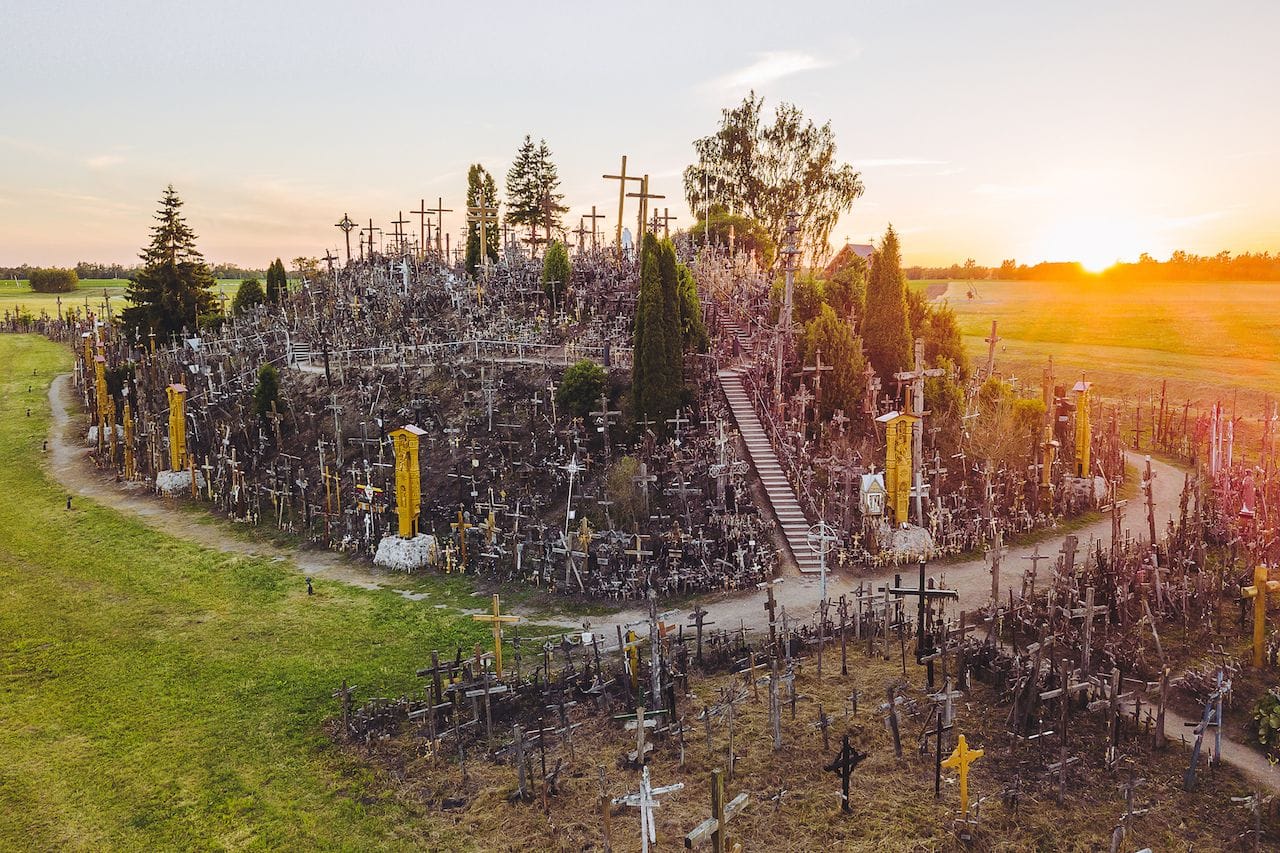More Than Just a Hill: Why Lithuania’s Hill of Crosses Is So Powerful
Nestled in the gentle slopes of northern Lithuania lies a place unlike any other—the Hill of Crosses. This isn’t just a hill with hiking trails or scenic views; it’s a landscape blanketed with over 100,000 crosses, each whispering a story of faith, resilience, and quiet defiance.
But the Hill of Crosses isn’t frozen in time. Every day, new crosses arrive, each one a silent prayer, a tangible memory, adding to the living history etched onto this extraordinary site. So, what is it about this place that draws people from around the world? Let’s delve into the mystery and meaning behind Lithuania’s Hill of Crosses.
Unveiling the Story Behind Lithuania’s Hill of Crosses: A Timeline Shrouded in Mystery
The precise origins of the Hill of Crosses are shrouded in captivating mystery, with legends interwoven with historical events. While no definitive answers exist, this ambiguity only adds to the site’s allure, allowing visitors to layer their own interpretations onto the landscape. However, exploring the historical context provides valuable clues:
Early Whispers (19th Century):
- The earliest crosses likely appeared in the early 1800s, potentially as expressions of grief and remembrance following the 1831 Uprising against Russian rule. This period saw Lithuanians fighting for their freedom and identity, and the Hill of Crosses may have served as a focal point for their hopes and sorrows.
A Symbol of Resistance (Late 19th – Early 20th Century):
- As Lithuania endured Tsarist Russia’s oppressive policies, which included banning the Lithuanian language and suppressing their culture, the act of leaving crosses took on a new meaning—defiance. Each cross became a silent protest, a testament to the enduring spirit of the Lithuanian people.
The Soviet Era: Destruction and Rebirth (1944-1990):
- The Soviet occupation marked a dark chapter for Lithuania. Religion was suppressed, and the Hill of Crosses, seen as a threat to Soviet ideology, was repeatedly bulldozed. However, undeterred, Lithuanians risked their lives to rebuild it, often under the cover of night. This act of defiance transformed the Hill into a powerful symbol of resistance against religious persecution. It became a beacon of hope, demonstrating the unconquerable nature of faith and national identity, even in the face of oppression.
Global Recognition and Papal Blessing (1991-Present):
- With Lithuania’s hard-won independence in 1991, the Hill of Crosses gained international recognition for its role in preserving national identity.
- Pope John Paul II’s visit in 1993 solidified its status as a global pilgrimage site. He declared it a place for “hope, peace, love, and sacrifice,” words that continue to resonate with visitors today.
Beyond 100,000: The Untold Story of the Hill of Crosses’ Growth
While the origins might be shrouded in mystery, one thing is clear: the Hill of Crosses is not a static monument. It’s a living testament to faith, with the number of crosses constantly evolving, reflecting the site’s enduring power and global reach.
- Estimates Vary, Growth is Constant: No precise count exists, as pilgrims continuously add crosses. However, estimations provide a glimpse into the remarkable growth:
- Lonely Planet (2007): Recorded 100,000 crosses
- Recent Estimates: Suggest 200,000 – 300,000 crosses
- Post-Independence (Since 1990): The number has more than doubled, indicating growing global significance.
Is the Hill of Crosses Worth Visiting? Unveiling the Secrets of Lithuania’s Pilgrimage Site
The Hill of Crosses is undoubtedly visually striking, but is it worth a visit? The answer depends on what you seek as a traveler.
For those drawn to:
- Unique cultural experiences: The Hill of Crosses offers a glimpse into a nation’s soul, its history interwoven with faith and resistance. You won’t find anything quite like it anywhere else.
- Spiritual reflection: The somber atmosphere, the wind whispering through thousands of crosses, and the tangible presence of faith create a unique space for contemplation. It’s a place to connect with something larger than yourself.
- Historical insights: The Hill of Crosses is a living monument to Lithuania’s tumultuous past, offering a tangible connection to its struggles and triumphs.
- Photographic opportunities: The visual impact of the Hill is undeniable. However, we encourage you to go beyond capturing the sheer scale and focus on capturing the details, the stories etched onto individual crosses.
…The answer is a resounding YES!
However, if your travel style leans towards:
- Thrilling attractions: The Hill of Crosses is a place for quiet reflection, not adrenaline-pumping activities.
- Fast-paced sightseeing: Allow ample time to absorb the atmosphere and appreciate the nuances of this unique site. It’s not a place to be rushed.
…Then the Hill of Crosses might not be the right fit for you.
Beyond Eerie: The Hill of Crosses – A Journey of Faith, History & Beauty
Stepping onto the Hill of Crosses is like stepping into a giant, silent storybook. Each cross, whether it’s a simple wooden one or an elaborate metalwork masterpiece, whispers tales of faith, loss, love, and hope.
You’ll find towering crosses that seem to touch the sky, and humble wooden ones, perhaps carved by hand centuries ago. Some are adorned with names, dates, rosaries, or faded photographs, each one a testament to the individual stories embedded in this sacred ground.
While photos might give you a sense of its scale, they can’t truly convey the profound atmosphere that envelops you when you stand among the crosses. The sound of the wind chimes, the sunlight glinting off crucifixes, the uneven paths beneath your feet—it’s a sensory experience that stays with you long after you leave.
Planning Your Visit: From Vilnius to the Hill of Crosses: A Practical Guide & Spiritual Journey
Location:
- The Hill of Crosses is located 12 km north of Šiauliai, Lithuania, approximately a 2-hour drive from the capital city, Vilnius.
Accessibility:
- Open year-round: The site is open 24/7 and free of charge.
- Getting there:
- From Vilnius: Rent a car for the most flexibility, or take a comfortable bus ride.
- From Šiauliai: Regular buses and taxis make the short trip to the Hill of Crosses.
Time Commitment:
- Plan to spend at least 2-3 hours at the site to fully appreciate its scale and atmosphere. This allows ample time for walking, reflecting, and taking photos.
Practical Tips:
- Dress appropriately: Wear comfortable shoes suitable for uneven terrain.
- Pack water and snacks: There are no facilities at the site.
- Be respectful: Maintain a respectful demeanor, remembering that this is a sacred place for many.
The Hill of Crosses: More Than Just a Destination
The Hill of Crosses is more than just a tourist attraction or even a pilgrimage site—it’s a testament to the enduring power of faith, resilience, and the human spirit’s ability to find hope, even in the darkest of times.
So, if you’re looking for a travel experience that goes beyond the ordinary, a journey that touches your soul as much as it expands your mind, then a visit to the Hill of Crosses should be at the top of your list.
Curious about other captivating destinations? Embark on a journey to uncover the tale of the elusive hawaiian mongoose and its impact on Hawaii’s unique ecosystem.
- Sept 31 Myth: Unveiling Calendar Secrets - March 18, 2025
- How Long & Till December 18, 2025: Accurate Countdown Guide - March 18, 2025
- Discover Japanese Artists: A Complete History - March 18, 2025

















4 thoughts on “The Hill of Crosses, Lithuania: A Journey of Faith, Resilience, and Hope”
Comments are closed.